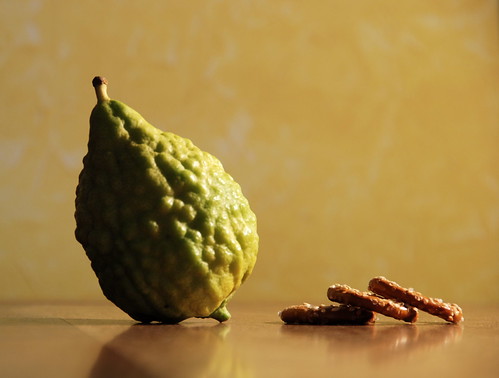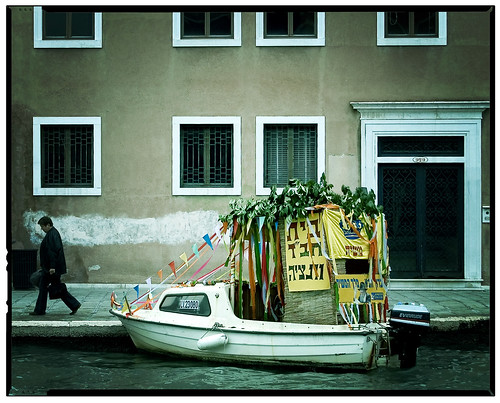Aside from living in a hut just when the autumn breezes and first rains are due (in the Middle East, anyhow - if you live in Vancouver summer has ended over a month ago!) - is most unusual for its mysterious and rich botanical symbolism.
Unlike Rosh Hashana (“Head of the Year”), with botanical symbols that were passed from mouth to ear for thousands of years (i.e.: the eating of pomegranates, apples-in-honey, beets, carrots and other sweet fruit and vegetables), Succot’s symbols are actually mentioned in the bible: “"And you shall take for yourself on the first day the fruit of goodly trees, branches of palm trees, and boughs of thick trees, and willows of the brook" (Leviticus. 23:40).
And what are these four species?
For as long as Jews can remember, “Fruit of goodly trees”, AKA “Etrog” has been the majestic citron fruit.
The branches of palm tree are not just branches, but the very beginning of a palm leaf, when it is still closed and looks more like a whip than anything else.
The “boughs of thick trees” was represented by myrtle branches.
And “willows of the brook” are simply willow branches. Not the weeping willows, but the upright kind which grows by the brooks.
The four species are symbolic representations of many things. Many of which I will not be able to tell you because I haven’t studied the topic more than an average Jew does. But the reason I bring these up and write about them on my blog (a blog about perfume, not about religion or Judaism) will become clear as we progress along my trail of thought...
The symbolic meaning of anything manifested in the material world is highly connected to its physical and tangible characteristics. And as every little Jewish girl and boy learn in kindergarten, the four species are four different permutations on the theme of smell and taste:
Etrog (Citron) has both flavour and fragrance;
Lulav (palm leaf) has flavour but no fragrance (this is in reference to the dates - the palm fruit - rather than the leaf);
Hadass (Myrtle) has fragrance but no flavour;
And finally, Arava (Willow) has neither fragrance nor flavour.
These qualities are symbolic of different qualities of a person – fragrance being attributed to good dees, while taste corresponds to knowledge and learning:
Etrog is a person who has both knowledge and learning and good deeds.
Lulav is a person who only has cerebral knowledge but misses the importance of good deeds.
Hadass symbolizes a person who does good deeds but is ignorant.
And finally, Arava (the willow), lacking in both taste and scent, represents a person who is both ignorant and that does not do good deeds.
I find it interesting that fragrance in this ancient oral tradition is corresponding to good deeds. Could it possibly be related to the fact that scent and emotions are so closely related? Is a person with a more sensitive sense of smell also more sensitive to other people’s feelings and therefore acts more morally? These are interesting thoughts, especially in the light of the sense of smell being so neglected in Western traditions for the most part, regarded as “inferior” or “animalic”.
Labels: 4 Speices, Botanical Symbolism, Etrog, Succot, Sukkot

















